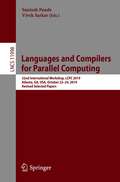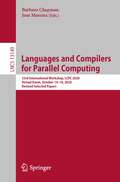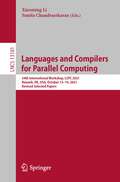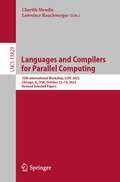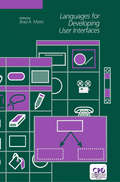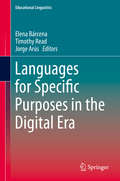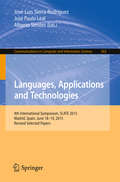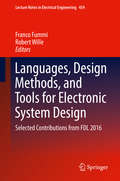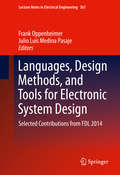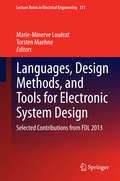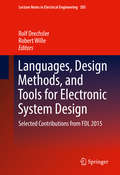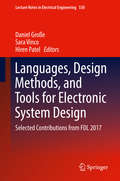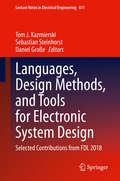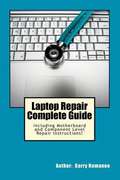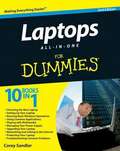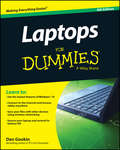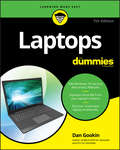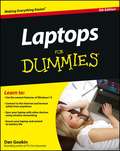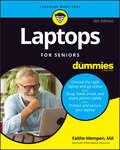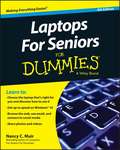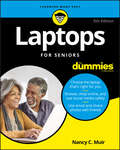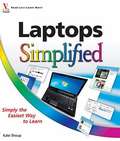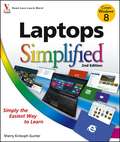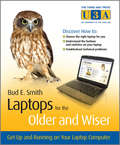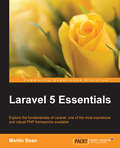- Table View
- List View
Languages and Compilers for Parallel Computing: 32nd International Workshop, LCPC 2019, Atlanta, GA, USA, October 22–24, 2019, Revised Selected Papers (Lecture Notes in Computer Science #11998)
by Santosh Pande Vivek SarkarThis book constitutes the thoroughly refereed post-conference proceedings of the 32nd International Workshop on Languages and Compilers for Parallel Computing, LCPC 2019, held in Atlanta, GA, USA, in October 2019.The 8 revised full papers and 3 revised short papers were carefully reviewed and selected from 17 submissions. The scope of the workshop includes advances in programming systems for current domains and platforms, e.g., scientific computing, batch/ streaming/ real-time data analytics, machine learning, cognitive computing, heterogeneous/ reconfigurable computing, mobile computing, cloud computing, IoT, as well as forward-looking computing domains such as analog and quantum computing.
Languages and Compilers for Parallel Computing: 33rd International Workshop, LCPC 2020, Virtual Event, October 14-16, 2020, Revised Selected Papers (Lecture Notes in Computer Science #13149)
by Barbara Chapman José MoreiraThis book constitutes the thoroughly refereed post-conference proceedings of the 33rd International Workshop on Languages and Compilers for Parallel Computing, LCPC 2020, held in Stony Brook, NY, USA, in October 2020. Due to COVID-19 pandemic the conference was held virtually. The 15 revised full papers were carefully reviewed and selected from 19 submissions. The contributions were organized in topical sections named as follows: Code and Data Transformations; OpenMP and Fortran; Domain Specific Compilation; Machine Language and Quantum Computing; Performance Analysis; Code Generation.
Languages and Compilers for Parallel Computing: 34th International Workshop, LCPC 2021, Newark, DE, USA, October 13–14, 2021, Revised Selected Papers (Lecture Notes in Computer Science #13181)
by Xiaoming Li Sunita ChandrasekaranThis book constitutes the thoroughly refereed post-conference proceedings of the 34th International Workshop on Languages and Compilers for Parallel Computing, LCPC 2020, held in Delaware, NE, USA, in October 2021.Due to COVID-19 pandemic the conference was held virtually. The 9 revised full papers were carefully reviewed and selected from 11 submissions. The conference covers all aspects of languages, compiler techniques, run-time environments, and compiler-related performance evaluation for parallel and high-performance computing. The scope of the workshop encompasses foundational results, as well as practical experience reports and bold new ideas for future systems.
Languages and Compilers for Parallel Computing: 35th International Workshop, LCPC 2022, Chicago, IL, USA, October 12–14, 2022, Revised Selected Papers (Lecture Notes in Computer Science #13829)
by Lawrence Rauchwerger Charith MendisThis book constitutes the thoroughly refereed post-conference proceedings of the 35th International Workshop on Languages and Compilers for Parallel Computing, LCPC 2022, held in Chicago, IL, USA, in October 2022. The 9 revised full papers were carefully reviewed and selected from 12 submissions. The conference covers all aspects of languages, compiler techniques, run-time environments, and compiler-related performance evaluation for parallel and high-performance computing. The scope of the workshop encompasses foundational results, as well as practical experience reports and bold new ideas for future systems.
Languages for Developing User Interfaces
by Brad A. MyersThis book brings together a number of researchers and developers from industry and academia who report on their work. It is of interest to language designers and the creators of toolkits, UIMSs, and other user interface tools.
Languages for Specific Purposes in the Digital Era
by Elena Bárcena Timothy Read Jorge ArúsExplores the direct relation of modern CALL (Computer-Assisted Language Learning) to aspects of natural language processing for theoretical and practical applications, and worldwide demand for formal language education and training that focuses on restricted or specialized professional domains. Unique in its broad-based, state-of-the-art, coverage of current knowledge and research in the interrelated fields of computer-based learning and teaching and processing of specialized linguistic domains. The articles in this book offer insights on or analyses of the current state and future directions of many recent key concepts regarding the application of computers to natural languages, such as: authenticity, personalization, normalization, evaluation. Other articles present fundamental research on major techniques, strategies and methodologies that are currently the focus of international language research projects, both of a theoretical and an applied nature.
Languages, Applications and Technologies
by José-Luis Sierra-Rodríguez José-Paulo Leal Alberto SimõesThis bookconstitutes the refereed proceedings of the 4th International Symposium onLanguages, Applications and Technologies, SLATE 2015, held in Madrid, Spain, inJune 2015. The 17 revised full papers presented werecarefully reviewed and selected from 57 submissions. The papers are organizedin topical sections on human-human languages; human-computer languages; computer-computer languages.
Languages, Design Methods, and Tools for Electronic System Design
by Robert Wille Franco FummiThis book brings together a selection of the best papers from the nineteenth edition of the Forum on specification and Design Languages Conference (FDL), which took place on September 14-16, 2016, in Bremen, Germany. FDL is a well-established international forum devoted to dissemination of research results, practical experiences and new ideas in the application of specification, design and verification languages to the design, modeling and verification of integrated circuits, complex hardware/software embedded systems, and mixed-technology systems.
Languages, Design Methods, and Tools for Electronic System Design
by Frank Oppenheimer Julio Luis Medina PasajeThis book brings together a selection of the best papers from the seventeenth edition of the Forum on specification and Design Languages Conference (FDL), which took place on October 14-16, 2014, in Munich, Germany. FDL is a well-established international forum devoted to dissemination of research results, practical experiences and new ideas in the application of specification, design and verification languages to the design, modeling and verification of integrated circuits, complex hardware/software embedded systems, and mixed-technology systems.
Languages, Design Methods, and Tools for Electronic System Design
by Marie-Minerve Louërat Torsten MaehneThis book brings together a selection of the best papers from the sixteenth edition of the Forum on specification and Design Languages Conference (FDL), which was held in September 2013 in Paris, France. FDL is a well-established international forum devoted to dissemination of research results, practical experiences and new ideas in the application of specification, design and verification languages to the design, modeling and verification of integrated circuits, complex hardware/software embedded systems and mixed-technology systems.
Languages, Design Methods, and Tools for Electronic System Design
by Robert Wille Rolf DrechslerThisbook brings together a selection of the best papers from the eighteenth editionof the Forum on specification and Design Languages Conference (FDL), which tookplace on September 14-16, 2015, in Barcelona, Spain. FDL is a well-established international forumdevoted to dissemination of research results, practical experiences and newideas in the application of specification, design and verification languages tothe design, modeling and verification of integrated circuits, complexhardware/software embedded systems, and mixed-technology systems.
Languages, Design Methods, and Tools for Electronic System Design: Selected Contributions from FDL 2017 (Lecture Notes in Electrical Engineering #530)
by Daniel Große Sara Vinco Hiren PatelThis book brings together a selection of the best papers from the twentiethedition of the Forum on specification and Design Languages Conference (FDL), which took place on September 18-20, 2017, in Verona, Italy. FDL is a well-established international forum devoted to dissemination of research results, practical experiences and new ideas in the application of specification, design and verification languages to the design, modeling and verification of integrated circuits, complex hardware/software embedded systems, and mixed-technology systems.Covers modeling and verification methodologies targeting digital and analog systems;Addresses firmware development and validation;Targets both functional and non-functional properties;Includes descriptions of methods for reliable system design.
Languages, Design Methods, and Tools for Electronic System Design: Selected Contributions from FDL 2018 (Lecture Notes in Electrical Engineering #611)
by Daniel Große Tom J. Kazmierski Sebastian SteinhorstThis book brings together a selection of the best papers from the twenty-first edition of the Forum on specification and Design Languages Conference (FDL), which took place on September 10-12, 2018, in Munich, Germany. FDL is a well-established international forum devoted to dissemination of research results, practical experiences and new ideas in the application of specification, design and verification languages to the design, modeling and verification of integrated circuits, complex hardware/software embedded systems, and mixed-technology systems.Covers Assertion Based Design, Verification & Debug;Includes language-based modeling and design techniques for embedded systems;Covers design, modeling and verification of mixed physical domain and mixed signal systems that include significant analog parts in electrical and non-electrical domains;Includes formal and semi-formal system level design methods for complex embedded systems based on the Unified Modelling Language (UML) and Model Driven Engineering (MDE).
Laptop Repair Complete Guide; Including Motherboard Component Level Repair!
by Garry RomaneoThis book will educate you on the Correct Process of Repairing The Entire Laptop, Including and concentrating more on Motherboard Repair Instruction, Screen Repairing, Component Level Diagnosing and Repairing. This is the 3rd Book Released By Author Garry Romaneo, The Worlds Leading Laptop Repair Technician, Author, and Consultant. The book will take you through the laptops disassembly process, Explaining in detail how to disassemble all laptops. You will then be taught all about Liquid Spills to Laptops. What to do, What not to do, How to Remove Liquid and How To Repair Any Damage from Liquid to parts or components. You will be shown all the various tools to be used in laptop repair both hand tools and electronic tools explained. This book will then explain the entire upper end repairing techniques. Replacing screens - how to- then it will show you in great detail how to disassembly the screen and repair or replace the LCD ccfl Bulb, the book will also discuss LED screens. You will be taught step by step how to solder a motherboard whether it is the components or the dc jack. The DC Jack Repair/Desoldering instructions are included. Most importantly, this book will teach you laptop motherboard repairing techniques. Learn to identify the parts and components on the motherboard, learn component replacement, motherboard testing techniques and more. This book also includes the authors Patented/Copyrighted and Trademarked Laptop Video Chip/GPU Motherboard Online Repair instruction. There is alot more included (Part Identification, Hard Drive Failure Issues etc. . . )so check it out now. Going Above And Beyond CompTia A+ Certification !!!
Laptops All-in-One For Dummies, 2nd Edition
by Corey SandlerThe all-in-one guide to buying, using, securing, and transporting a laptop-it's ten books in one! If you want to take a computer with you on a trip, to a coffee shop, or into the kitchen when you're cooking, laptops are just the ticket. They're portable, powerful, and popular-but they're not desktops, so you'll want to know what you're doing from the get-go. This terrific, ten-minibooks-in-one book covers all the bases: how to choose the best laptop for you, what you need to know when you're on the road, how to get more productive and more. Shows you how to keep your laptop running smoothly and safely at home, at work, in the classroom, and on the road Includes ten books in one: Choosing the Best Laptop, Setting Up Your Laptop, Running Basic Windows Operations, Using Common Applications, Playing with Multimedia, Managing Your Power Supply, Upgrading Your Laptop, Networking and Linking to the Internet, Protecting Your Laptop, and Troubleshooting Common Problems Offers advice and tips on using your laptop safely and efficiently, including what accessories you need Reflects the very latest technologies, including Windows 7 and the new Microsoft Office 2010 This easy-to-follow For Dummies guide tells you everything you need to know about laptops!
Laptops For Dummies
by Dan GookinLaptops For Dummies, 3rd Edition shows you how to use your laptop to its fullest potential, from how to purchase a laptop and what to do when you first open the box to how to keep your laptop safe and running smoothly.You will discover how to choose and purchase the right laptop for you, how to set up and maintain your laptop, customize user accounts, adding your laptop to networks, printing, and connecting to the Internet. In this updated and revised edition, find information about synchronizing with the desktop, coordinating email pickup between two machines, remote access to the desktop, networking, power management, storage, and especially laptop security. You'll find out how to:Navigate all your laptop's componentsUse keyboard shortcuts and a mouseOrganize and manage files and accountsPrint files and add your laptop to a networkProperly equip your laptop carrying case with tools and resourcesManage the power supplyAdd software tools to synchronize and update files between a laptop, a PDA, and a desktop or office serverIn addition to the basics, find lists of ten battery tips and tricks, ten handy laptop accessories, and ten things you should keep in your laptop carrying case in Laptops for Dummies, 3rd Edition, a convenient and handy guide!
Laptops For Dummies
by Dan GookinThe latest on getting the most from laptops and tablets Not that long ago, laptops were seen as luxuries. Now they’re practically an essential for many people, and—as faster computing power and super-sharp displays make many of them the equal of a desktop—the new wave of lightweight laptops is increasingly replacing the home PC with its bulky tower and multiple cords. Plus, you can use your laptop when chilling on the couch or venturing out for a quick coffee! In this fully updated edition of Laptops For Dummies, bestselling tech writer Dan Gookin takes a friendly walk through everything you need to know, from the basics (if you’re new to laptops) all the way up to the latest hardware and tech updates—including the recent release of Windows 10. Along the way you’ll learn how to synchronize your laptop with other machines, coordinate email pickup across devices, and beef up your security. You’ll also learn how to Choose the right laptop Check out tablet options Troubleshoot problems Maintain and upgrade Whether you’re choosing a new laptop or want to maximize what you’re getting from the one you have, Laptops For Dummies has you covered, wherever you want to work—or play!
Laptops For Dummies, 5th Edition
by Dan GookinHit the road with your laptop and this must-have For Dummies guide If you're like most people, your laptop is taking the place of your PC. Whether you're on the road, working at home, or multitasking, your laptop is now an essential, trusted tool. Just in time, beloved and popular author Dan Gookin returns with a new edition that covers the very latest in laptops. From synchronizing with your desktop and coordinating e-mail to maintaining security, networking, working in Windows 8, adding your smartphone to the mix, and more, this book makes understanding laptops simpler than you ever thought possible. Shares the latest basics about laptops, such as new technologies, current processors available, and steps to update memory and hard drive capabilities Covers the new Windows 8 operating system and other popular laptop operating systems, as well as netbooks, wireless networking, and smartphone tethering Explores remote access to the desktop, power management, storage, security, and much more Examines the benefits of mobility for students, employees, and anyone who needs to work on the go Helps you work on the road, employ and enjoy multimedia, and use your laptop professionally Laptops For Dummies, 5th Edition is the fun and friendly guide that will get you going and on the go with your laptop in no time!
Laptops For Seniors For Dummies
by Faithe WempenThe basics you need to get more comfortable with laptops, without any of the fluff Laptops For Seniors For Dummies is just for you. We help readers in the 55+ club get the most out of their laptops. You&’ll discover how to choose the best laptop for your needs and how to use Microsoft Windows, to share photos, surf the web, use e-mail, and much more. With large text, clear graphics, and easy-to-follow instructions, this For Seniors For Dummies guide will get you up to speed on your new device in no time. Even if you&’re upgrading from a typewriter, we can help you choose the right laptop to buy, understand your operating system, use files and folders, download and install software, and stay safe online. It&’s all the stuff you need to know to make your laptop work for you. Choose and purchase the right laptop for your needs Navigate your Windows 10 or 11 operating system with confidence and discover useful programs Connect to Wi-Fi, go online, send e-mails, and get started with social media Protect and secure your laptop and your personal dataWhether you&’re purchasing your first laptop or upgrading from older technology, this Dummies guide will take you step by step through everything you need to know to get laptop savvy.
Laptops For Seniors For Dummies
by Nancy C. MuirIt's never too late to get up and running on a laptopJust bought your first laptop and not sure where to start? Here's the book you need. Easy-to-follow instructions (plus really easy-to-read fonts!) help you unlock the most convenient and fun aspects to using a laptop. Get advice on selecting the right laptop for you, learn to navigate the operating system without hassle, and get comfortable with files and folders, wireless printing, downloading apps, syncing to mobile phones, and maintaining security. You'll soon be using your trusty laptop for shopping, social networking, instant messaging, e-mailing, playing games, and more.Helps the growing number of seniors who are embracing technology and often using a laptop for the first time get quickly up to speedCovers basics such as how to use the keyboard and mouse, access the Internet, get familiar with Windows 8, and moreGuides you through staying safe online, using various Office applications, connecting to a ?wireless network, working with files and folders, playing games, and, of course, having funFeatures clear, easy-to-follow instructions and a large font and helpful images for easy readingLaptops For Seniors For Dummies, 3rd Edition is specially designed and written to help you become a tech-savvy senior in no time at all.
Laptops For Seniors For Dummies
by Nancy C. MuirGet the most out of your laptop or tablet PC Laptops For Seniors For Dummies makes it easier than ever for the 50+ set to enjoy a laptop or tablet PC by taking the intimidation out of working with a new device. Featuring larger text and images, this bestseller empowers you to keep up with your kids or grandkids with all the latest and greatest that technology has to offer. Assuming no prior knowledge, this accessible guide starts from the beginning by helping you select the right laptop or tablet for your needs, shows how the various parts connect together, and illustrates how to use the keyboard and mouse. Once you've chosen your device and mastered the basics, this book will help you navigate your way around the Windows 10 operating system, show you how to use the touchscreen capabilities, and so much more. In no time at all, you'll wonder why you hadn't bought a laptop sooner! Keep in touch with family and friends through email and social networking sites Get on the internet to shop and browse your favorite sites Ensure your information is safe online Use the latest applications for work and play Everything you love about your desktop computer can be conveniently taken on the go with a laptop. Laptops For Seniors For Dummies will help you have fun and feel successful with your new device.
Laptops Simplified
by Kate ShoupA step-by-step visual guide to choosing and using a laptopLaptops continue to outsell desktop computers. Whether you're thinking of purchasing a laptop or already own one, this colorful, visual guide is packed with information you need to know. Large, full-color screen shots and step-by-step instructions show you how to choose the right laptop for your needs and how to use Windows 7 and Office 2010, connect to wireless networks, stay safe online, extend battery life, connect mobile devices, and so much more.Laptops are rapidly becoming the computer of choice; this easy-to-follow visual guide covers everything new laptop users need to knowVisual learners will quickly grasp the "read less-learn more" approach, with large, full-color screen shots and numbered, step-by-step instructions for dozens of common tasksCovers various types of laptops and points to consider when choosing one, how to use Windows 7 and Office 2010, and connecting to 3G and Wi-Fi networksExplores maintenance and battery life issues, security, working with cameras and mobile devices, and troubleshootingIf you appreciate visual learning, you'll find Laptops Simplified is the quickest and easiest way yet to start being productive with your laptop.
Laptops Simplified
by Sherry Kinkoph GunterStep-by-step guidance on all things laptop-related, aimed at visual learnersA little overwhelmed by the selection of laptops out there and how to get started using one? Laptops Simplified, Second Edition is here to help! Boasting a straightforward, jargon-free approach, this easy-to-navigate guide takes the fear out of exploring the subject of laptops and breaks it down to the basics. Veteran author Sherry Kinkoph Gunter demystifies common laptop issues such as finding the laptop that is right for you, setting it up, troubleshooting it, and maintaining it. Covers the very basics of connecting to wireless networks while away from home; working with a variety of devices such as cameras, cell phones, and extra monitors; and making sure all security precautions are in place for safe online experiencesFeatures full-color screen shots and numbered, step-by-step instructions on how to get up and running with your laptopIncludes coverage of the new Windows 8 operating systemShares helpful advice from a veteran author on getting the most out of your laptopLaptops Simplified, Second Edition puts you on your way to becoming a confident and savvy laptop user!
Laptops for the Older and Wiser
by Bud E. SmithHelpful, easy-to-follow guide for new laptop users over the age of 50Laptops are fun and more popular than ever, but they are still computers and come with their own set of issues: easier to steal, more likely to be dropped, often dependent on wireless Internet access, and other concerns. If you're entering the computer world as an older adult--and wondering about laptops--this straightforward, helpful book is for you.Written in full color with lots of screenshots and clear, easy-to-read type, this friendly guide walks you through the process from start to finish: selecting which type of laptop is right for you (PC or Mac?), handling setup, safely adding wireless Internet access, staying secure online, and much more.Provides guidance for purchasing your laptop, bringing it home, and setting upWalks you through all the various connections, buttons and switchesShows you how to connect wirelessly at home and abroad, safelyDelves into laptop accessories, whether you need them, and how to get the most out of themAddresses online security issues and how to stay safeExplores troubleshooting problems and how to save your precious dataPrepare properly, enjoy the freedom, and maybe even show the kids a thing or two with this fun and practical guide!
Laravel 5 Essentials
by Martin BeanThis book is intended for PHP web developers who have an interest in Laravel and who know the basics of the framework in theory, but don't really know how to use it in practice. No experience of using frameworks is required, but it is assumed you are at least familiar with building dynamic websites in PHP already.
